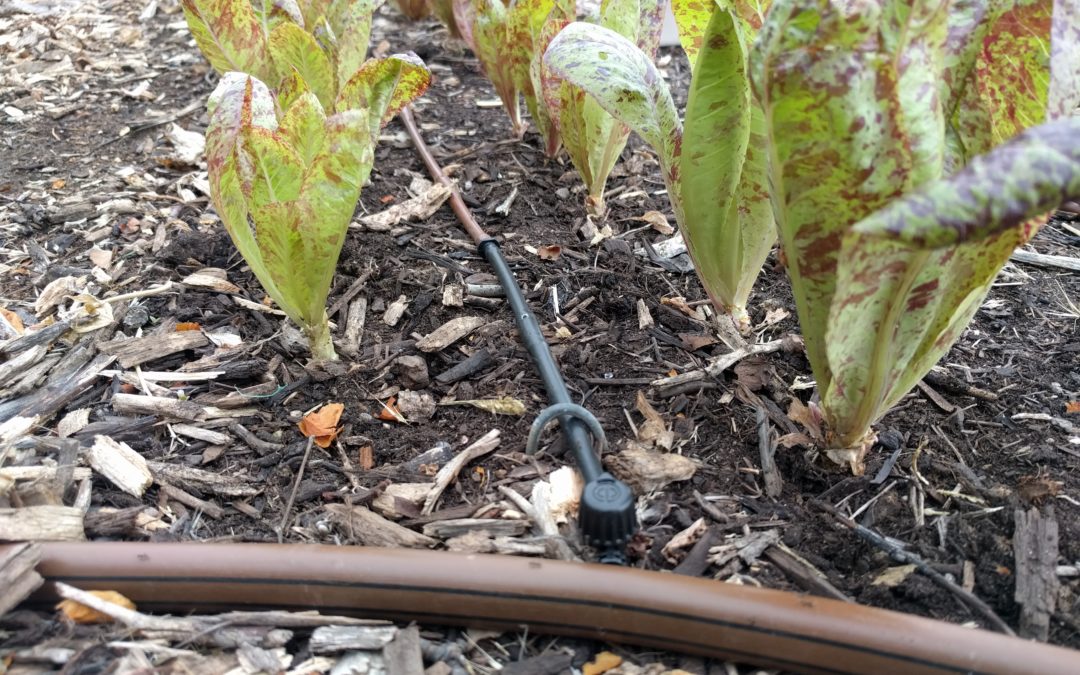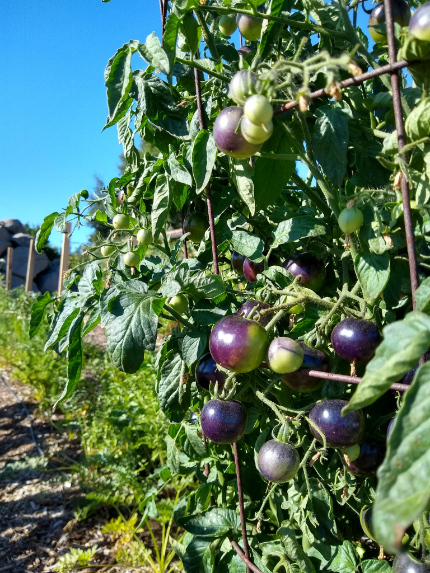My short answer is: Start with 45 minutes, observe, and adjust. But there are a lot of variables, which is why observing and adjusting is necessary.
Of the many factors that affect how long you should run a drip irrigation system on vegetables, one is the output of the emitters, which usually range in volume from 0.5 gallons per hour up to 4 gallons per hour. So you can imagine that running a system for one hour will give plants a very different amount of water according to the type of emitters used.
Then there is the number of emitters. There are drip lines with inline emitters spaced every 6 inches up to every 18 inches, or even wider. So if a broccoli plant is drinking from multiple emitters under it on a drip line that has emitters spaced every 6 inches, you will need to run that system for a shorter duration than if the emitters were spaced every 18 inches.
On top of that — or under it, actually — is the soil type. In a raised box for vegetables that is filled with potting mix-type soil, a drip system should not be run as long as for vegetables planted in the ground in a clayey soil. A clayey soil can soak up a lot of water and hold onto it, but a loose and light potting mix-type soil lets water percolate down, down, down to below where a plant’s roots will reach.
For reference
And there are even more variables, but let me now give you a jumping off point by saying that I’m running my own drip irrigation on my vegetables for 30 minutes every three days in October, and I have 0.5 gallon-per-hour emitters spaced every 12 inches, and my soil is a sandy loam (plants are in the ground). There’s a reference point for you.
I’ve played with running my drip lines daily for a shorter time, and I’ve played with running them after longer intervals for an hour or more, but in my sandy loam soil runs of more than an hour just drive the water below the level of plant roots. Sandy soils don’t draw the water out laterally like clay soils do.
On the other hand, I do like running the system for at least 30 minutes each time because it encourages the water to spread laterally as much as possible, which gives the plant roots a larger volume of soil to drink from. So I’ve settled on runs of 30-45 minutes.
I have gardening friends who have clay-type soil and they usually water their vegetables on drip for longer, up to two hours at a time, but less often.
At the height of summer, I usually run my drip irrigation on vegetables for 30 minutes every other day or for 45 minutes every three days. My summer vegetables have done well on both of these regimens in years past.
Observing and adjusting
So I recommend to you that you start with a run of 45 minutes, and then watch how the plants respond. After a couple days, is there any wilting, especially after the sun cools in late afternoon? Then raise the time to an hour or decrease the interval (e.g. from three days to two days) and see if it makes enough of a difference. Or does the surface of the soil still appear wet after a couple days? Then definitely don’t run the system again yet.
Wait to water again until the soil is no longer wet — but still somewhat moist — where the plant roots are. That’s going to be at least a knuckle deep. Because plants don’t have roots at the very surface, you shouldn’t judge whether to water again based on how dry the surface looks. Sometimes you’ll find that the surface is dry but after scratching it’s still very moist an inch down. And that’s the only depth where it starts to count.
Another useful observation to make is to see how deep your 45-minute run percolated. A day after the irrigation, next to an emitter, dig down and see how far it is wet. If it is wet far deeper than your plants have roots (mine don’t root more than a foot and a half deep), then you ought to reduce the time or extend the interval.
So, the short of it again: Start with 45 minutes, observe, and adjust.
All of my Yard Posts are listed HERE





Hi Greg, Thanks for this useful information! I’m just curious about how much water you use on average in summer time, is it possible for you to make an estimate of your water usage in gallons / sq ft in your garden? I guess it also depends on the type of crop you are growing?
Thanks, really enjoying your website!
Hi Klaas,
This is an interesting question, and I started to look at my records and try to calculate, but I now realize that it’s not quite possible. While I do record how long I run my irrigation during each event, there are too many adjustments that I make that I don’t record, such as turning on a second dripline to tomatoes once they grow large enough, or turning off a dripline to seedlings halfway through an irrigation run because they don’t need as much water as mature plants.
But how much water I use per square foot of vegetable garden would be a useful thing to know. Maybe next summer I’ll try to take enough notes such that I can calculate it. Easier would be to carefully note the total watering I do on a single bed. That feels more realistic.
Hey Greg – thanks so much for the article. I’ve been wondering on two things:
1> How do you think about drip systems that pass different plants, with different “drinking” requirements. So, for instance, a mature tomato plant vs. a bit of cilantro (more shallow roots). Do you segment your garden with different run times, or does everything get the same schedule and still grow OK?
2> How does one deal with fertilizer? (do you just add the liquid fertilizer manually and pause a drip?)
Thanks!
I hate compressions couplings. The removable Irritec Perma-Loc Tubing fittings for drip tubing are so much easier to work with. PermaLoc fittings allow you to:
-Re-use any drip tubing that was connected with them–you can easily can change your set-up as the garden matures or as you see fit to re-configure.
-Easily screw on and unscrew off so you don’t need much hand stretch to join
-Avoid the leaks or blow-outs that happen with compression fittings.
I highly recommend–from DripDepot.com, and other places.
Hi MT,
I also prefer the lock or simple barb fittings over compression. If they’re used on the correctly sized tubing, there is no leaking and no blow outs either, in my experience (as long as the water pressure isn’t too high).
I also like Drip Depot, from whom I’ve ordered many times. I second all of your recommendations here! Thanks for contributing.
What size emitters are you basing your times on? 1gpm, 2gpm etc.